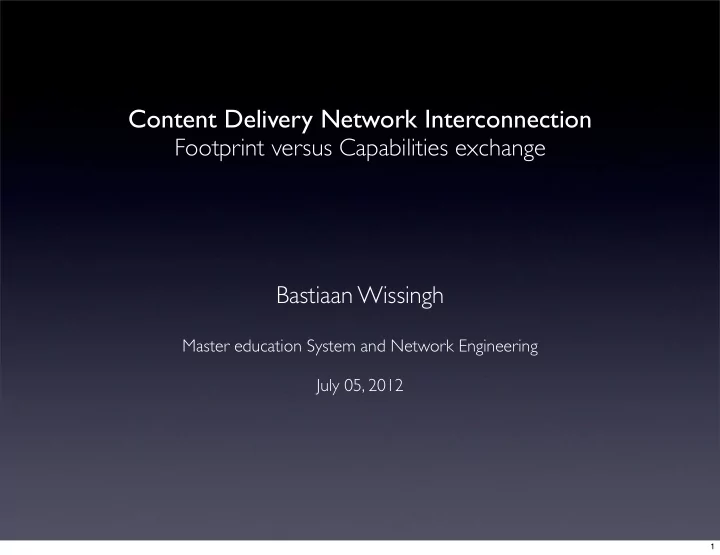

Content Delivery Network Interconnection Footprint versus Capabilities exchange Bastiaan Wissingh Master education System and Network Engineering July 05, 2012 1
Agenda • Introduction • Research Questions • Footprint and Capabilities • Purpose of Footprint and Capabilities • Exchange protocols • Conclusion Please save questions until the end of the presentation 2
Introduction - CDN Illustration of a Content Delivery Network 3
Introduction - CDNi • Multiple reasons to Interconnect different CDNs; • Extend on Footprint • Offload own network load • Extend on Capabilities • Standardisation process by IETF CDNi Working Group 4
Introduction - CDNi Illustration of CDNi Framework proposed by IETF CDNi Working Group Picture source: http://tools.ietf.org/id/draft-ietf-cdni-framework-00.txt 5
Research Questions • How can Footprint and Capabilities be defined? • Which proposed method is more suitable for exchanging footprints and capabilities between different CDNs? 6
Footprint (FP) • Region for which CDN is able to deliver content • Three suggested candidates: • Set of country, state, city combinations • Autonomous System numbers • Set of IP subnets 7
Capabilities (CAP) • Features, services and states CDN can/cannot meet • Information about • Caches • Resources • Network capabilities • Administrative capabilities 8
Purpose of FP and CAP • Let uCDN select proper dCDN to redirect end-user request. • IETF idea based on Footprint, only when insufficient also on Capabilities • Leads to incorrect decision • Comparable with for example selecting supermarket for groceries • Better to combine both in selection process 9
Exchange protocols Protocol Footprint Capabilities Information Information Standard BGP X BGP Extended Communities X Attribute BGP-TE X BGP-AIGP X HTTP X Extension to M-BGP for CDNi X X ALTO X X Exchange protocols suggested by IETF CDNi Working Group 10
M-BGP for CDNi • Makes use of Multiprotocol extension to BGP • M-BGP defines two new NLRI’s • MP_REACH_NLRI • MP_UNREACH_NLRI • Optional non-transitive • Defines three MP NLRI’s only for CDNi • FootPrint Element • FootPrint Reachability • CAPability 11
M-BGP for CDNi • Elements exchanged via 3 messages: • Footprint Element Advertisement • Footprint Reachability Advertisement • Capabilities Advertisement • For each element, separate database should be maintained 12
ALTO • Application Layer Traffic Optimisation protocol • Client - server architecture • Server can provide operator policies, geographical location, network proximity and transmission costs. • Network Map (Footprint) • Cost Map (Capabilities) 13
ALTO • Besides ALTO-Core, three services: • Map filtering service • Endpoint property service • Endpoint cost service • No special additions needed for use with CDNi • uCDN client of multiple servers in different dCDNs 14
M-BGP versus ALTO M-BGP ALTO • Pro: • Pro: • Footprint layer-3 • Still in draft stage • Flexible setup of information • Con: framework • Capabilities application • No special additions layer information not needed for CDNi • Con: layer-3 • Optional non-transitive • Single point of failure possibility 15
Conclusion • How can Footprint and Capabilities be defined? • Footprint is a region for which CDN is able to deliver content represented by AS numbers • Capabilities are features, services and states CDN can/ cannot meet • Should be combined in selection process • Which proposed method is more suitable for exchanging footprints and capabilities between different CDNs? • ALTO protocol better candidate for footprint and capabilities exchange 16
Future Research • Decentralized ALTO version • Other exchange protocols • Framework standardisation by other organizations 17
Thank you for your attention! Questions? 18
Recommend
More recommend